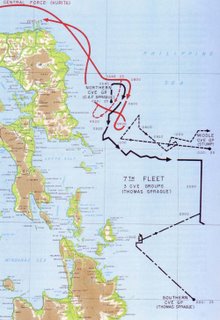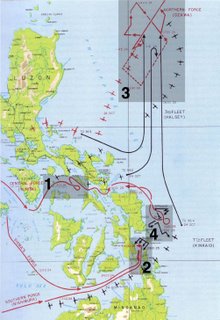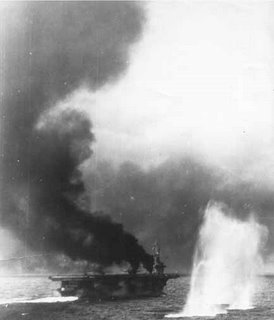





The last great surface fleet action began with the Japanese decsion to counter MacArthur's amphibious landing on Leyte in the Philippines. Splitting their fleet and using their suddenly impotent carrier force to lure Halsey's American carriers away from the scene, the Japanese fleet met the Americans in an epic four-day running battle, very well set out in Thomas Cutler's book The Battle of Leyte Gulf: 23-26 October 1944 and in James D. Hornfischer's The Last Stand of the Tin Can Sailors: The Extraordinary World War II Story of the U.S. Navy's Finest Hour.
All the elements of war are present - the "fog" caused by missed communications, misunderstood communications and human failings and yet, out of chaos, came victory for the Americans.
One Japanese fleet sails into the narrow Surigao Strait and finds an American force waiting with mines, torpedo boats and a classic "crossing the T" force of battleships. The "Battle of Surigao Strait" is the last surface action of big gun ships in history.
A second Japanese force exits San Bernandino Strait and runs into a rag-tag collection of Escort carriers and gets engaged by little destroyer escorts and the "Taffys" - an engagement so furious that the Japanese mistook the escorts for cruisers and the escort carriers for Halsey's fleet.
Out of the smoke of battle come the great ships and crews who refused to give up the fight in the "Battle of Samar". The "small boys" -destroyers and destroyer escorts Samuel B. Roberts, Hoel, Heermann and Johnston fought a furious rear-guard action to allow their slow escort carriers to attempt a run to safety. Hoel sunk. Roberts sunk. Johnston sunk. But only after attacking and attacking and weaving their way back to the attack against faster, bigger and better armed ships. Stinging the Japanese ships and slowing their advance as they tried to figure out what they were dealing with. And the pilots of Navy planes, simulating strafing runs without ammunition.
The courage of the Americans causes the Japanese to withdraw, never to pose a serious threat to the US Navy again.
Days to remember and to honor those who fought and died in the Battle of Leyte Gulf.
Good summary here. Army view here. Info on USS Johnston (DD-557) here. Hoel here. Samuel B. Roberts (DE-413) here. Gambier Bay here. St Lo here.
Medal of Honor citation for CDR Earnest Evans, CO of Johnston reads:
For conspicuous gallantry and intrepidity at the risk of his life above and beyond the call of duty as commanding officer of the U.S.S. Johnston in action against major units of the enemy Japanese fleet during the battle off Samar on 25 October 1944. The first to lay a smokescreen and to open fire as an enemy task force, vastly superior in number, firepower and armor, rapidly approached. Comdr. Evans gallantly diverted the powerful blasts of hostile guns from the lightly armed and armored carriers under his protection, launching the first torpedo attack when the Johnston came under straddling Japanese shellfire. Undaunted by damage sustained under the terrific volume of fire, he unhesitatingly joined others of his group to provide fire support during subsequent torpedo attacks against the Japanese and, outshooting and outmaneuvering the enemy as he consistently interposed his vessel between the hostile fleet units and our carriers despite the crippling loss of engine power and communications with steering aft, shifted command to the fantail, shouted steering orders through an open hatch to men turning the rudder by hand and battled furiously until the Johnston, burning and shuddering from a mortal blow, lay dead in the water after 3 hours of fierce combat. Seriously wounded early in the engagement, Comdr. Evans, by his indomitable courage and brilliant professional skill, aided materially in turning back the enemy during a critical phase of the action. His valiant fighting spirit throughout this historic battle will venture as an inspiration to all who served with him.Heroes.
UPDATE: Added information about the loss of USS St Lo, sunk by a Kamikaze on October 25, 1944.
Reposted from last year.

No comments:
Post a Comment